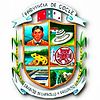Coclé Province
Coclé is a province of Panama. The province is in central Panama on the southern coast along the Pacific Ocean. The provincial capital is the city of Penonomé.
Coclé Province
Provincia de Coclé | |
|---|---|
 Saint John the Baptist cathedral, Penonomé | |
 Coclé, in red, in Panama | |
| Coordinates (Seat of Government): 8°30′N 80°30′W / 8.500°N 80.500°W | |
| Country | |
| Founded | 1985 |
| Capital | Penonomé |
| Districts | Aguadulce, Antón, La Pintada, Natá, Olá, Penonomé |
| Government | |
| • Governor | Sugeidy Flores |
| Area | |
| • Total | 4,946.6 km2 (1,909.9 sq mi) |
| Population (2010)[2] | |
| • Total | 233,708 |
| • Density | 47/km2 (120/sq mi) |
| Demonym | Coclesano |
| Time zone | UTC+1 (Eastern Time) |
| • Summer (DST) | UTC-5 (CEST) |
| ISO 3166 code | PA-2 |
History
changeThis province was created in 1855 with the name of Department of Coclé, during the presidency of Justo de Arosemena. Its name was changed to province on 20 October 1985.
Location
changeThe Coclé province borders the Colón province to the north, the Panamá Oeste province to the east, the Pacific Ocean and the Herrera province to the south and the Veraguas province to the west.
Geography
changeThe Coclé province has an area of 4,946.6 km2 (1,909.89 sq mi).[2]
The Cordillera Central ("Central Mountain range) is in the northern part of the province and divides the province in two drainage basins; to the north, the rivers flow to the Caribbean Sea but to the south of the mountain range the rivers flow to the Pacific Ocean.
In the southern part of the province there is a large plain that gets to the Pacific coast.
Protected areas
changeIn the northeast of the province is the Parque Nacional General de División Omar Torrijos Herrera, a national park.
Demographics
changeThe people of the province are known as Coclesanos (women:Coclesanas).[3]
The Coclé province had a population, in 2010, of 233,708, for a population density of 47.2 inhabitants/km2.[2]
Evolution of the population in Coclé province

Administrative divisions
changeThe Coclé province is divided in six districts, which are divided into 44 corregimientos.[3]
| Districts | Capital | Area[2] (km²) |
Population[2] (2010) |
Density (inh./km²) |
Corregimientos |
|---|---|---|---|---|---|
| Aguadulce | San Juan Bautista de Aguadulce | 469.3 | 43,360 | 92.4 | San Juan Bautista de Aguadulce, El Cristo, El Roble, Pocrí, Barrios Unidos |
| Antón | Antón | 747.8 | 54,632 | 73.1 | Antón, Cabuya, El Chirú, El Retiro, El Valle, Juan Díaz, Río Hato, San Juan de Dios, Santa Rita, Caballero |
| La Pintada | La Pintada | 1,030.0 | 25,639 | 24.9 | La Pintada, El Harino, El Potrero, Llano Grande, Piedras Gordas, Las Lomas, Llano Norte |
| Natá | Natá de los Caballeros | 605.2 | 18,465 | 30.5 | Natá, Capellanía, El Caño, Guzmán, Las Huacas, Toza |
| Olá | Olá | 385.7 | 5,875 | 15.2 | Olá, El Copé, El Palmar, El Picacho, La Pava |
| Penonomé | Penonomé | 1,708.6 | 85,737 | 50.2 | Penonomé, Cañaveral, Coclé, Chiguirí Arriba, El Coco, Pajonal, Río Grande, Río Indio, Toabré, Tulú, El Valle de San Miguel |
Economy
changeCoclé is primarily an agricultural area, with sugar and tomatoes as major crops. The province has a number of well-known beaches, such as Santa Clara, Farallon and Rio Hato, and tourist activity has increased in recent years.
Gallery
changeReferences
change- ↑ "Decreto 314 de 2 de julio de 2014" (PDF) (in Spanish). Gaceta Oficial de Panamá. Retrieved 31 January 2017.
- ↑ 2.0 2.1 2.2 2.3 2.4 2.5 "Cuadro 11. Superficie, población y densidad de población en la República, según Provincia, Comarca indígena, Distrito y Corregimiento: Censos de 1990, 2000 y 2010" (XLS). Instituto Nacional de Estadística y Censo, Contraloría General de la República de Panamá. Retrieved 31 January 2017.
- ↑ 3.0 3.1 "Provincia de Coclé" (in Spanish). Editorial Ox. Archived from the original on 28 October 2012. Retrieved 1 February 2017.
Other websites
change- Media related to Coclé Province at Wikimedia Commons
- Statoids.com

